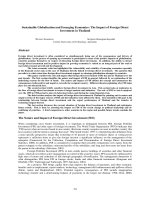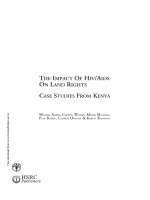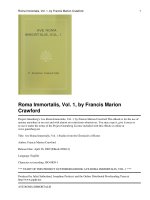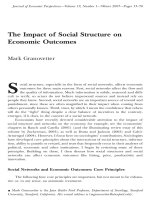Slides ICAM 1 4 explain the impact of poor cost information
Bạn đang xem bản rút gọn của tài liệu. Xem và tải ngay bản đầy đủ của tài liệu tại đây (2.53 MB, 43 trang )
Explain the Impact of Poor Cost
Information
© Dale R. Geiger 2011
1
How much does a box of cereal cost?
© Dale R. Geiger 2011
2
Terminal Learning Objective
• Task: Explain the Impact of Poor Cost Info on a
Decision
• Condition: You are training to become an ACE
with access to ICAM course handouts, readings,
and spreadsheet tools and awareness of
Operational Environment (OE)/Contemporary
Operational Environment (COE) variables and
actors
• Standard: with at least 80% accuracy:
• Demonstrate understanding of Cost Terminology
• Explain the impact of poor cost information on a
decision
© Dale R. Geiger 2011
3
There Are Many Possible Ways
to Measure Costs
Consider the Following Types of Cost:
direct, indirect, variable, fixed, sunk, period,
inventoriable, reimburseable, capital, standard,
conversion, prime, carrying, incremental, separable,
joint, project, controllable, current, historical, normal,
discretionary, full, responsibility, imputed,
opportunity, mixed, out-of pocket, relevant,
target, absorption, average, quality, estimated,
and unit
© Dale R. Geiger 2011
4
Relevance of Information
•
•
•
•
Has anyone recently purchased a new vehicle?
What were your top three criteria? Why?
Where did you get your information? Why?
What influenced your decision?
• How will you use the vehicle?
• How much will you drive it?
• In what stage of your life are you?
© Dale R. Geiger 2011
5
Relevance of Information
• How might your information needs differ if
you were deciding where to pursue your
Masters degree?
• How would your decision criteria differ?
• What different sources of information would
you choose?
© Dale R. Geiger 2011
6
Let’s Start a Business
• What should we sell? List five products:
Product: Cost:
1.
2.
3.
4.
5.
Total Cost:
© Dale R. Geiger 2011
7
Let’s Start a Business
• Costing methodology:
• Calculate unit cost
• Add a markup on cost to guarantee a profit
• Set selling price
© Dale R. Geiger 2011
8
Let’s Start a Business
• Calculate Average Unit $ Cost:
Total Cost
/ 5 units =
$
per unit
• Add a 30% markup on cost to calculate
Selling Price:
$
per unit
* (1 + .30) = $
per unit
© Dale R. Geiger 2011
9
Let’s Start a Business
What’s wrong with this picture?
Product:
Selling Price:
1.
2.
3.
4.
5.
© Dale R. Geiger 2011
10
Conclusions
• Followed the costing methodology to the
letter
• Calculated unit cost and selling price to the
penny
• What went wrong?
• Costing methodology not appropriate for our
purpose of setting prices for diverse items
© Dale R. Geiger 2011
11
FASAB’s SFFAS #4
• Read the Executive Summary of Federal Accounting
Standards Advisory Board’s Statement of Federal
Financial Accounting Standards #4
• How do we know that FASAB Considers Cost Accounting
a High Priority?
• List the Five Fundamental Elements of Cost Accounting:
1.
2.
3.
4.
5.
© Dale R. Geiger 2011
12
FASAB’s SFFAS #4
• Read the Executive Summary of Federal Accounting
Standards Advisory Board’s Statement of Federal
Financial Accounting Standards #4
• How do we know that FASAB Considers Cost
Accounting a High Priority?
• List the Five Fundamental Elements of Cost Accounting:
1. Accumulating and reporting costs of activities
2. Establishing responsibility segments
3. Determining full costs of goods and services
4. Recognizing the costs of goods and services provided
among federal entities
5. Using appropriate methodologies to assign costs
© Dale R. Geiger 2011
13
FASAB’s SFFAS #4
• Read the Introduction to SFFAS #4
• What are three goals of federal financial
reporting?
1.
2.
3.
© Dale R. Geiger 2011
14
FASAB’s SFFAS #4
• Read the Introduction to SFFAS #4
• What are three goals of federal financial
reporting?
1. Costs of specific programs and activities and the
composition of, and changes in, those costs;
2. Efforts and accomplishments associated with
federal programs and their changes over time and
in relation to costs
3. Efficiency and effectiveness of the government's
management of its assets and liabilities
© Dale R. Geiger 2011
15
FASAB’s SFFAS #4
Who are the users of federal financial
information?
Users
Decisions:
1.
2.
3.
© Dale R. Geiger 2011
16
FASAB’s SFFAS #4
Who are the users of federal financial
information?
Users
Decisions:
1. Government
-spend resources to
Managers
achieve expected results
2. Congress
-program decisions
Federal Executives -evaluate performance
3. Citizens
-resource allocation
© Dale R. Geiger 2011
17
FASAB’s SFFAS #4
What are objectives of managerial cost
accounting information?
1.
2.
3.
© Dale R. Geiger 2011
18
FASAB’s SFFAS #4
What are objectives of managerial cost
accounting information?
1. Provide program managers with relevant and
reliable information relating costs to outputs and
activities
2. Provide relevant and reliable cost information to
assist the Congress and executives in making
decisions about allocating federal resources
3. Ensure consistency between costs reported in
financial reports and costs reported to managers
© Dale R. Geiger 2011
19
FASAB’s SFFAS #4
List the five topics addressed by the standard:
1.
2.
3.
4.
5.
© Dale R. Geiger 2011
20
FASAB’s SFFAS #4
List the five topics addressed by the standard:
1. Requirement for cost accounting
2. Responsibility segments
3. Full cost
4. Inter-entity costs
5. Costing methodology
© Dale R. Geiger 2011
21
FASAB’s SFFAS #4
List the five purposes for using cost accounting
information:
1.
2.
3.
4.
5.
© Dale R. Geiger 2011
22
FASAB’s SFFAS #4
List the five purposes for using cost accounting
information:
1. Budgeting and cost control
2. Performance measurement
3. Determining reimbursements and setting fees
and prices
4. Program evaluations
5. Making economic choice decisions
© Dale R. Geiger 2011
23
FASAB’s SFFAS #4
Managerial cost accounting is the process of…
1.
2.
3.
4.
5.
…cost information useful to both internal and
external groups
© Dale R. Geiger 2011
24
FASAB’s SFFAS #4
Managerial cost accounting is the process of…
1. accumulating
2. measuring
3. analyzing
4. interpreting
5. reporting
…cost information useful to both internal and
external groups
© Dale R. Geiger 2011
25









